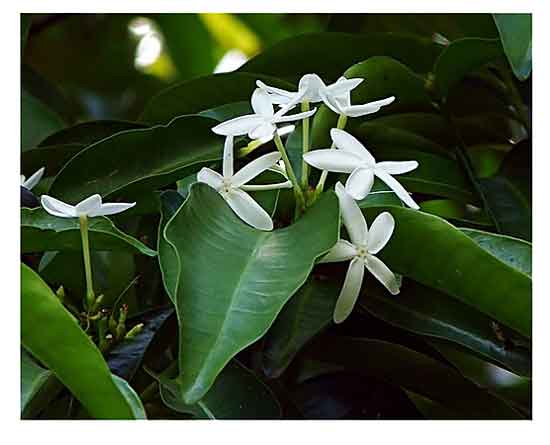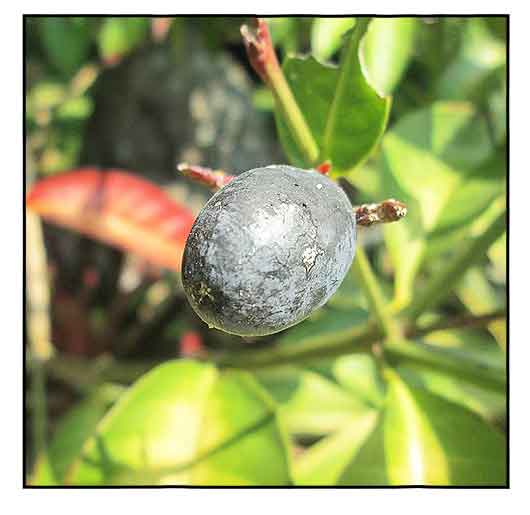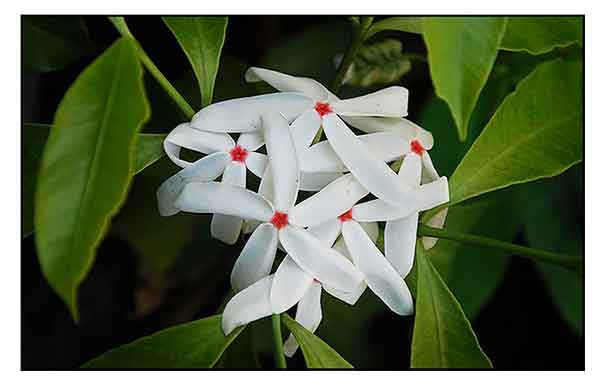 Gen info Gen info
- Apocynaceae is a family of flowering plants that includes trees, shrubs, herbs, stem succulents, and vines, commonly known as the dogbane family, as the taxa was used as dog poison. Apocynaceae is derived from the Greek Apocynum, meaning "dog away". Many of the plants yield a milky latex, and many species are poisonous if ingested, being rich in alkaloids and cardiac glycosides. The genera comprises more than 5,000 species in five subfamilies. (14)
-
Etymololy: The genus name Kopsia honors the Dutch botanist Jan Kops (1765-1849). The specific epithet arborea derives from Latin arboreus, meaning arboreal or tree-like.
Botany
Kopsia arborea is a tree up to 15 m tall. Branches greenish, terete, slightly compressed, puberulent when young. Petiole 5-15 cm; leaf blade elliptic, narrowly elliptic, or narrowly ovate, 8-24 x 3.5-8.5 cm, glabrous, apex acute or short acuminate; lateral veins 10-20 pairs. Cymes corymbose, many flowered; peduncle to 14 cm, puberulent or glabrous; bracteoles narrowly oblong, puberulent or glabrous. Pedicel 3-4 mm. Sepals narrowly oblong, 4-6 mm, puberulent or glabrous. Corolla white, tube ca. 2.5 cm; lobes narrowly oblong, 1.5-2 cm. Disc scales narrowly oblong, longer than ovary, fleshy. Ovary ovoid, puberulent. Drupes black or blue-black, ellipsoid, 2.5-3.5 x 1.5-2 cm. (Flora of China) (2)
 Kopsia arborea is an unarmed evergreen tree, 6-14 m tall, with compact crown and trunk, of 10-30 cm of diameter, with greyish bark tending to flake off with the age; from the wounds of all the plant exudes abundantly a white latex. The leaves, on a 0,5-1 cm long petiole, are opposite, simple, ovate to elliptic with caudate to blunt acuminate apex and slightly wavy margins, 6-25 cm long and 3-10 cm broad, coriaceous, of glossy intense green color that turns dark red before falling. The inflorescences, on a 1-8 cm long peduncle, are biparous terminal or lateral cymes, 5-15 cm long, carrying numerous flowers, on a 0,4 cm long pedicel, hypocrateriform (corolla with the spread margins almost perpendicular to a long thin tube), wholly white or with a very slight yellow shade at the centre. Calyx with 5 oblong sepals, about 0,5 cm long, corolla with corolline tube, 2-3 cm long, and 5 oblong-linear lobes 1-2 cm long and 0,4-0,6 cm broad; the flowers emit a pleasant smell. The fruits, usually solitary, are ellipsoid drupes of blackish blue color, 1,5-3 cm long and of 1-2 cm of diameter, containing only one seed. (3) Kopsia arborea is an unarmed evergreen tree, 6-14 m tall, with compact crown and trunk, of 10-30 cm of diameter, with greyish bark tending to flake off with the age; from the wounds of all the plant exudes abundantly a white latex. The leaves, on a 0,5-1 cm long petiole, are opposite, simple, ovate to elliptic with caudate to blunt acuminate apex and slightly wavy margins, 6-25 cm long and 3-10 cm broad, coriaceous, of glossy intense green color that turns dark red before falling. The inflorescences, on a 1-8 cm long peduncle, are biparous terminal or lateral cymes, 5-15 cm long, carrying numerous flowers, on a 0,4 cm long pedicel, hypocrateriform (corolla with the spread margins almost perpendicular to a long thin tube), wholly white or with a very slight yellow shade at the centre. Calyx with 5 oblong sepals, about 0,5 cm long, corolla with corolline tube, 2-3 cm long, and 5 oblong-linear lobes 1-2 cm long and 0,4-0,6 cm broad; the flowers emit a pleasant smell. The fruits, usually solitary, are ellipsoid drupes of blackish blue color, 1,5-3 cm long and of 1-2 cm of diameter, containing only one seed. (3)
Distribution
- Native to the Philippines.
- Also native to Andaman Is., Borneo, china, Hainan, Jawa, Laos, Lesser Sunda Is., Malaya, Nicobar Is., Queensland, Sulawesi, Sumatera, Thailand, Vietnam.
- In various habitats from sea level to 1,500 m altitude.
 Constituents Constituents
- GC study of ethanolic extract of Kopsia arborea fruit showed 21 peaks with vincadifformine (RT 24.496 and AUC 22.360%). Total flavonoid content was 39.83 mg GAE/g. Total phenolic content was 63.42 QCE/g; total alkaloid, 478.81 mg/g; and total tannin content 327,016 mg TAE/g. (4)
- Study of aerial parts isolated two new indole alkaloids, kopsiyunnanines G (1) and H (2). (5)
- Study of aerial parts isolated five new alkaloids, including three 19,20-epoxytubotaiwine stereoisomers, viz. kopsiyunnanines F1 (1), F2 (2), and F3 (3), (Z)-isocondylocarpine (4), and (Z)-isocondylocarpine N-oxide (5), along with five known tubotaiwine-type indole alkaloids. (6)
- Study
isolated two new indole alkaloids, kopsiyunnanines J1 and J2. (7)
- Study of leaves isolated four indole alkaloids, viz. methyl 11,12-methylenedioxychanofruticosinate, methyl-N1-decarbomethoxychanofruticosinate, methyl 11,12-methylenedioxy-N1-decarbomethoxy-chanofruticosinate and methyl 11,12-methylenedioxy-N1-decarbomethoxy-Δ14,15-chanofruticosinate. (8)
- Study of kernels isolated two new monoterpenoid indole alkaloids, (2 R, 7 R, 16 R, 20 R, 21S)-12-hydroxypleiocarpine (1) and (2S, 7 R, 16S, 20 R, 21S)-N-methoxycarbonyl-11,12-methylenedioxy-Δ14,15-kopsinaline (2), along with six known alkaloids. (9)
- Study of twigs isolated a new eburnane-type alkaloid, phutdonginin (1), together with 8 known alkaloids: 19-OH-(-)- eburnamonine (2), melodinine E (3), kopsinine (4), kopsilongine (5), kopsamine (6), (-)-methylenedioxy-1 1,12-kopsinaline (7), decarbomethoxykopsiline (8), and vincadifformine (9). (see study below) (11)
- Study of 90% ethanol aqueous extract of aerial parts of K. arborea isolated three new monoterpenoid indole alkaloids, kopsiarborines A-C (1-3). (see study below) (12)
Properties
- Caution: All parts of the plant are poisonous if ingested, in particular, the fruits due to the indole alkaloids. (4)
-
Considered aphrodisiac.
- Studies have suggest sexual and testosterone stimulatory, acetylcholinesterase inhibitory, antibacterial, anti-inflammatory, analgesic, anticancer properties
.
Parts used
Bark, leaves, fruits.
Uses
Edibility
- Caution: Fruit is highly poisonous.
Folkloric
- No reported folkloric medicinal use in the Philippines.
- In Chinese traditional medicine, bark decoction used as enema; leaves and fruit used for treatment of sore throat and tonsilitis. (2) Also used for treatment of rheumatoid arthritis and dropsy.
- In Indonesia, considered an aphrodisiac; fruits traditionally used to improve male sexuality.
(4)
Studies
• Stimulation of Sexual Behavior and Testosterone Level: Study evaluated the potential of K. arborea ethanolic extract to stimulate sexual behavior and testosterone levels in male and female albino rats. Vincadifformine alkaloid was detected as a dominant compound. Extract treatment at 300 mg/kbw for 26 days produced highest increase in mount and intromission frequency, higher and similar to sildenafil citrate. Treatment also increase testosterone. (4)
• Indole Alkaloids / Kernels: Study of kernels isolated two new monoterpenoid indole alkaloids, (2 R, 7 R, 16 R, 20 R, 21S)-12-hydroxypleiocarpine (1) and (2S, 7 R, 16S, 20 R, 21S)-N-methoxycarbonyl-11,12-methylenedioxy-Δ14,15-kopsinaline (2), along with six known alkaloids. The alkaloids were tested for cytotoxicity against two human cancer cell lines. (9)
• Anti-Inflammatory / Analgesic / Kernels: Study isolated and purified 23 monoterpenoid indole alkaloids (MIAs) from barks and leaves of K. officinalis amd were evaluated for invitro anti-inflammatory activities based on suppression of lipopolysaccharide-activated inflammatory mediators in RAW 264.7 macrophage cells. Anti-inflammatory and analgesic activities were assessed in vivo with carrageenan-induced paw edema and acetic acid-stimulated writhing in mice models. Most of isolates showed significant anti-inflammatory effects in vitro by inhibiting inflammatory mediators (COX-2, IL-1β, and TNF-α). In-vivo study showed that 12-hydroxy-19(R)-hydroxy-ibophyllidine (1) and 11,12-methylenedioxykopsinaline N4-oxide (5) remarkably decreased the number of writhing, while kopsinic acid (8), (−)-kopsinilam (12), and normavacurine-21-one (20) significantly relieved paw edema, respectively, better than the positive control aspirin. (10)
• Acetylcholinesterase Inhibitory / Antibacterial / Twigs: Study of twigs isolated a new eburnane-type alkaloid, phutdonginin (1), together with 8 known alkaloids. Kopsinine (4) and decarbomethoxykopsiline (8) showed AChE inhibition with MIR of 12.5 and 6.25 µg, respectively, compared with control galanthamine (0.004 µg). Compounds 1 and 2 showed moderate antibacterial activity against E coli TISTR780 with MIC of 32 mg/mL. (see constituents above) (11)
• Cytotoxicity / Anticancer Alkaloids / Aerial Parts: Study of 90% ethanol aqueous extract of aerial parts of K. arborea isolated three new monoterpenoid indole alkaloids, kopsiarborines A-C (1-3). The isolated alkaloids were tested for invitro cytotoxic potentials against six human lung cancer cell lines (A549, ATCC, H446, H460, H292, and 94-D). Alkaloids 1 and 3 showed significant cytotoxic activities against all tested tumor cell lines with IC50s less than 20 µM. (12)
• Histamine and Beta-Hexosaminidase Inhibition: Study evaluated crude alkaloids derived from different parts of K. arborea for inhibitory activity on histamine and beta-hexosaminidase release in rat basophilic leukemic (RBL-2H3) cells. All samples significantly inhibited (p<0.001) histamine release in
RBL-2H3 cell except K. arborea roots. The % inhibition of histamine release
by crude alkaloid extracted from leaves was higher than ketotifen fumarate (positive control). Alkaloid from roots exhibited highest inhibition of beta-hexosaminidase release and activity. Results suggest the alkaloid compounds have the ability to inhibit mast cell degranulation via inhibition of histamine and beta-hexosaminidase release and has potential as alternative anti-allergic agent. (13)
Availability
- Wild-crafted.
- Seeds in the cybermarket.
|

![]()






